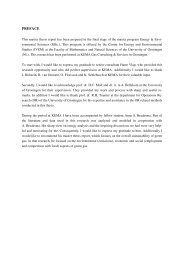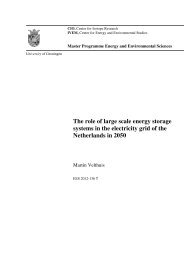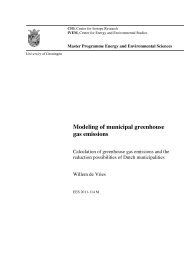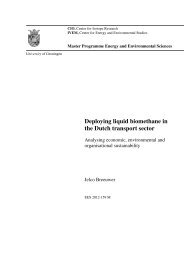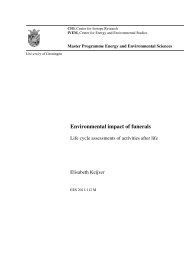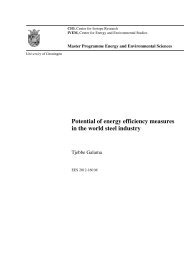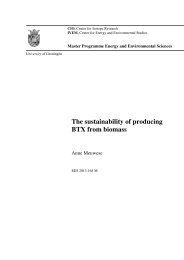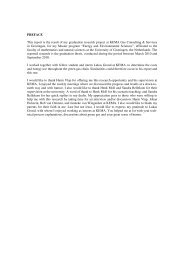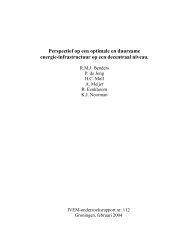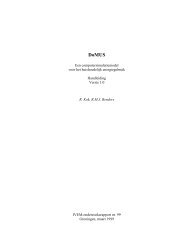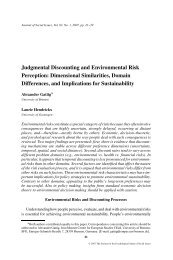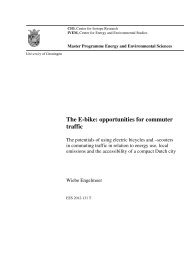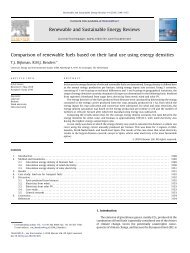Broadband dye-sensitized upconversion of near-infrared light
Broadband dye-sensitized upconversion of near-infrared light
Broadband dye-sensitized upconversion of near-infrared light
Create successful ePaper yourself
Turn your PDF publications into a flip-book with our unique Google optimized e-Paper software.
NATURE PHOTONICS DOI: 10.1038/NPHOTON.2012.158 ARTICLES<br />
Photoluminescence intensity (a.u.)<br />
6<br />
4<br />
2<br />
0<br />
750<br />
Nanoparticles/IR-806<br />
Nanoparticles<br />
× 1,000<br />
940 960<br />
800 850 900 950<br />
Excitation wavelength (nm)<br />
Figure 5 | Upconversion action spectra. Experimental <strong>upconversion</strong><br />
excitation spectra <strong>of</strong> b-NaYF 4:Yb,Er nanoparticles/IR-806<br />
(0.80/0.006 mg ml 21 ;bluecircles)andb-NaYF 4:Yb,Er nanoparticles<br />
(0.80 mg ml 21 ; green triangles), both dissolved in CHCl 3 . The emission<br />
intensity is integrated in the 500–685 nm range with excitation from a<br />
2 mW c.w. laser. The red line shows the squared absorption spectrum. Inset:<br />
wavelength range from 940 to 1,000 nm, magnified by a factor <strong>of</strong> 1,000.<br />
<strong>upconversion</strong> by the non-<strong>sensitized</strong> process around 975 nm is<br />
simply invisible on this scale. However, as the inset shows, the<br />
non-<strong>sensitized</strong> <strong>upconversion</strong> does take place in this range.<br />
Importantly, this process has a similar efficiency and spectral<br />
response for non-coated and <strong>dye</strong>-coated nanoparticles, which<br />
proves that the <strong>upconversion</strong> properties <strong>of</strong> the nanoparticles were<br />
not compromised following <strong>dye</strong> attachment. Although the peak-topeak<br />
(at 975 nm versus at 800 nm) ratio <strong>of</strong> non-<strong>sensitized</strong> and <strong>sensitized</strong><br />
<strong>upconversion</strong> is ≏1:1,100, the integrated spectral response in the<br />
720–1,000 nm range from the <strong>dye</strong>-coated nanoparticles, as shown in<br />
Fig. 5, is ≏3,300 times stronger than that <strong>of</strong> the non-<strong>sensitized</strong><br />
nanoparticles. This result lends further support for the DUC mechanism<br />
operating in the excitation range where IR-806 absorbs, and<br />
‘direct’ <strong>upconversion</strong> by the nanoparticles operating in the range<br />
where the nanoparticles absorb.<br />
In conclusion, we have demonstrated that <strong>dye</strong>-<strong>sensitized</strong> <strong>upconversion</strong><br />
<strong>of</strong> nanoparticles yields a dramatically increased <strong>upconversion</strong><br />
efficiency. Further improvement can be obtained by<br />
optimization <strong>of</strong> the <strong>dye</strong> emission and nanoparticle absorption spectral<br />
overlap. Moreover, we propose that by using suitable co-sensitizing<br />
sets <strong>of</strong> antenna molecules and upconverting nanoparticles,<br />
together absorbing the full desired spectral range <strong>of</strong> <strong>light</strong> to be<br />
upconverted, it will be possible to obtain even greater broadband<br />
<strong>upconversion</strong>. Such broadband sensitization, in combination with<br />
higher quantum yield upconverters, would change <strong>upconversion</strong><br />
from an academic and exotic phenomenon into a realistic and<br />
viable tool for increasing the efficiency <strong>of</strong> photovoltaic devices.<br />
Furthermore, as the absorption spectrum <strong>of</strong> the <strong>dye</strong>-<strong>sensitized</strong><br />
upconverter can be tuned, analyses and imaging techniques in<br />
medicine and diagnostics 13 based on upconverting nanoparticles<br />
will also benefit greatly from the proposed approach.<br />
Methods<br />
Synthesis <strong>of</strong> IR-806. The functionalization reaction was performed using standard<br />
Schlenk-line techniques in dry glassware and under a dry nitrogen atmosphere.<br />
A mixture <strong>of</strong> IR-780 iodide (2-[2-[2-chloro-3-[(1,3-dihydro-3,3-dimethyl-1-propyl-<br />
2H-indol-2-ylidene)ethylidene]-1-cyclohexen-1-yl]ethenyl]-3,3-dimethyl-1propylindolium<br />
iodide; 500 mg, 0.75 mmol) and 4-mercaptobenzoic acid (231 mg,<br />
1.50 mmol) in dimethylformamide (DMF) (20 ml) was stirred at room temperature<br />
for 17 h. DMF was removed under vacuum at 40 8C, and the residue was dissolved in<br />
CH 2Cl 2 (5 ml). The solution was filtered through a 0.45 mm polytetrafluoroethylene<br />
syringe filter and diethyl ether (150 ml) was added slowly to precipitate the product.<br />
The precipitate was collected by centrifugation, washed with diethyl ether, and dried<br />
under vacuum to afford 506 mg (0.65 mmol, 86%) <strong>of</strong> gold-coloured crystals. For<br />
characterization data see Supplementary Information.<br />
980<br />
Synthesis <strong>of</strong> NaYF 4:Yb,Er and NaYF 4 nanoparticles. NaYF 4:Yb,Er nanoparticles<br />
were synthesized according to a method described in the literature 29 . The reaction<br />
was performed using standard Schlenk-line techniques in dry glassware under a dry<br />
N 2 atmosphere. CF 3COONa (544 mg, 4 mmol), Y(CF 3COO) 3 .3H 2O (752 mg,<br />
1.56 mmol), Yb(CF 3 COO) 3 .3H 2 O (226 mg, 0.40 mmol), Er(CF 3 COO) 3 .3H 2 O<br />
(23 mg, 0.04 mmol) and oleylamine (20 ml) were added to a 100 ml three-neck<br />
round-bottom flask. With vigorous stirring, the mixture was heated to 100 8C at<br />
reduced pressure for 0.5 h to remove water and oxygen; heating was then continued<br />
up to 340 8C in the presence <strong>of</strong> nitrogen. After 1 h at 340 8C, heating was stopped.<br />
When the reaction temperature reached 80 8C, ethanol (150 ml) was added.<br />
The nanoparticles were isolated by centrifugation. The as-precipitated nanoparticles<br />
were washed three times with ethanol and then dispersed in 5 ml <strong>of</strong> chlor<strong>of</strong>orm.<br />
Undoped NaYF 4 nanoparticles were synthesized similarly, without the addition <strong>of</strong><br />
the Yb and Er salts.<br />
Sample preparation for UV-vis-NIR absorption and fluorescence measurements.<br />
All samples were prepared and measured under an atmosphere <strong>of</strong> nitrogen. The<br />
samples for UV-vis-NIR absorption and standard fluorescence measurements were<br />
prepared by adding different amounts <strong>of</strong> NaYF 4:Yb,Er nanoparticles to 0.01 mg <strong>of</strong><br />
IR-806 in CHCl 3 (4 ml) . The solutions were then stirred for 2 h at room temperature.<br />
The samples for <strong>upconversion</strong> fluorescence measurements were prepared by adding<br />
different amounts <strong>of</strong> IR-806 to 40 mg <strong>of</strong> NaYF 4:Yb,Er nanoparticles in CHCl 3<br />
(1 ml). The solutions were stirred for 2 h at room temperature, then diluted 50 times<br />
for measurement.<br />
Spectroscopy. For the <strong>upconversion</strong> luminescence measurements, a Ti:sapphire<br />
laser system (MIRA-900-F) was used as the excitation source. Luminescence spectra<br />
and lifetime measurements were performed in c.w. and pulsed modes (repetition<br />
rate <strong>of</strong> 76 MHz), respectively. The excitation <strong>light</strong> was focused into a 1-mm-thick<br />
sample cell by a lens with a focal length <strong>of</strong> 75 mm. This resulted in a focal spot <strong>of</strong><br />
35+10 mm (FWHM) level. The excitation power was controlled by a gradient<br />
neutral density filter and set at 2 mW for all experiments, with the exception <strong>of</strong> the<br />
power-dependence measurements. The emission was collected with a right-angled<br />
geometry by an f/2 collimating lens and subsequently focused by an f/4 lens onto<br />
the slit <strong>of</strong> the spectrograph. The (time-resolved) emission detection was performed<br />
using a streak camera system equipped with a spectrograph (Hamamatsu C5680)<br />
running with the vertical time axis sweep <strong>of</strong>f while recording c.w. emission spectra.<br />
Received 17 April 2012; accepted 9 June 2012;<br />
published online 15 July 2012<br />
References<br />
1. Shockley, W. & Queisser, H. J. Detailed balance limit <strong>of</strong> efficiency <strong>of</strong> p–n<br />
junction solar cells. J. Appl. Phys. 32, 510–519 (1961).<br />
2. Conibeer, G. Third-generation photovoltaics. Mater. Today 10, 42–50 (2007).<br />
3. Wang, H.-Q., Batentschuk, M., Osvet, A., Pinna, L. & Brabec, C. J. Rare-earth ion<br />
doped up- conversion materials for photovoltaic applications. Adv. Mater. 23,<br />
2675–2680 (2011).<br />
4. Van der Ende, B. M., Aarts, L. & Meijerink, A. Lanthanide ions as spectral<br />
converters for solar cells. Phys. Chem. Chem. Phys. 11, 11081–11095 (2009).<br />
5. De Wild, J., Meijerink, A., Rath, J. K., van Sark, W. G. J. H. M. & Schropp, R. E. I.<br />
Upconverter solar cells: materials and applications. Energy Environ. Sci. 4,<br />
4835–4848 (2011).<br />
6. Strümpel, C. et al. Modifying the solar spectrum to enhance silicon solar cell<br />
efficiency—an overview <strong>of</strong> available materials. Sol. Energy Mater. Sol. Cells 91,<br />
238–249 (2007).<br />
7. Trupke, T., Shalav, A., Richards, B. S., Würfel, P. & Green, M. A. Efficiency<br />
enhancement <strong>of</strong> solar cells by luminescent up-conversion <strong>of</strong> sun<strong>light</strong>. Sol. Energy<br />
Mater. Sol. Cells 90, 3327–3338 (2006).<br />
8. Shalav, A., Richards, B. S., Trupke, T., Kramer, K. W. & Gudel, H. U. Application<br />
<strong>of</strong> NaYF 4:Er 3þ up-converting phosphors for enhanced <strong>near</strong>-<strong>infrared</strong> silicon<br />
solar cell response. Appl. Phys. Lett. 86, 013505 (2005).<br />
9. Shan, G.-B. & Demopoulos, G. P. Near-<strong>infrared</strong> sun<strong>light</strong> harvesting in <strong>dye</strong><strong>sensitized</strong><br />
solar cells via the insertion <strong>of</strong> an upconverter-TiO 2 nanocomposite<br />
layer. Adv. Mater. 22, 4373–4377 (2010).<br />
10. De Wild, J., Rath, J. K., Meijerink, A., van Sark, W. G. J. H. M. & Schropp, R. E. I.<br />
Enhanced <strong>near</strong>-<strong>infrared</strong> response <strong>of</strong> a-Si:H solar cells with b-NaYF 4:Yb 3þ<br />
(18%), Er 3þ (2%) <strong>upconversion</strong> phosphors. Sol. Energy Mater. Sol. Cells 94,<br />
2395–2398 (2010).<br />
11. Fischer, S. et al. Enhancement <strong>of</strong> silicon solar cell efficiency by <strong>upconversion</strong>:<br />
optical and electrical characterization. J. Appl. Phys. 108, 044912 (2010).<br />
12. Shalav, A., Richards, B. S. & Green, M. A. Luminescent layers for enhanced<br />
silicon solar cell performance: up-conversion. Sol. Energy Mater. Sol. Cells 91,<br />
829–842 (2007).<br />
13. Haase, M. & Schäfer, H. Upconverting nanoparticles. Angew. Chem. Int. Ed. 50,<br />
5808–5829 (2011).<br />
14. Baluschev, S. et al. Up-conversion fluorescence: noncoherent excitation by<br />
sun<strong>light</strong>. Phys. Rev. Lett. 97, 143903–06 (2006).<br />
NATURE PHOTONICS | VOL 6 | AUGUST 2012 | www.nature.com/naturephotonics 563<br />
© 2012 Macmillan Publishers Limited. All rights reserved.



